
The Harley-Davidson Servi-Car is a three-wheeled utility motorcycle that was manufactured by Harley-Davidson from 1932 to 1973.

The Harley-Davidson Servi-Car is a three-wheeled utility motorcycle that was manufactured by Harley-Davidson from 1932 to 1973.
The Servi-Car was designed during the Great Depression when Harley-Davidson was desperate to expand its product base to increase sales. [1] Targeted at the automotive service industry, the vehicle was designed for assisting at roadside breakdowns and delivering cars to customers. For this reason, it was available with a tow bar at the front and a large 60 Ah battery. [2] (The tow bar was used to tow the Servicar from the rear of a car, not vice-versa). It allowed one person to transfer a car from one location to another and drive themselves back; after driving the car to its destination, the delivery driver would unhitch the Servi-Car and ride it back to the garage. [3] [4]
In addition to its intended use for car delivery and retrieval, the Servi-Car was also popular as a utility vehicle for small businesses and mobile vendors. It proved to be particularly popular with police departments, some of which still used Servi-Cars into the 1990s. [2]

The models offered in 1932, the first year of production, were:
In 1933, the GDT, with large box and tow bar, was added to the line. [5]
In 1942, the small and large boxes were replaced with a standardized intermediate-sized box that was manufactured for Harley-Davidson by the Chas. Abresch Co. in Milwaukee, Wisconsin. A gold, red, and black water transfer decal from this company was affixed to the top inside of the box lid.[ citation needed ] This box continued to be installed until 1966, after which it was replaced by a fiberglass box; all preceding boxes were made from steel. [6]
The Servi-Car used variations of Harley-Davidson's 45 cubic inch flathead. From 1932 to 36, the Servi-Car used the engine from the solo R model. [1] It was changed in 1937 to the engine used in the W model, which differed mainly in having a recirculating oil system instead of the constant-loss system of the R. [2] [7] The "W" flathead engine continued until the end of production in 1973, despite the "W" solo series being replaced by the "K" series in 1952. [2] [8]
An electric starter became available on the Servi-Car in 1964, making it the first civilian Harley with an electric starter, one year before the debut of the Electra Glide. [2] [9] [10]
When the Servi-Car was introduced in 1932, it used the same transmission as the R solo model. [2] This was replaced the next year by a constant-mesh transmission with three speeds and a reverse gear. [11]
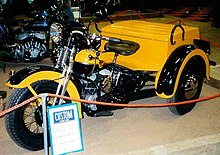
The Servi-Car was designed in the early part of the Great Depression for the conditions of its day, in which roads might be crude and unpaved. It has a rigid rear axle with a differential. [12] The rear axle has a track of 42 inches (1,100 mm), similar to the track of most cars at the time. This allowed it to follow ruts that had already been worn into the road. [4]
A prototype of the Servi-Car with rear suspension was tested but found to be unstable. [4] The production model's axle is mounted directly to the frame with no suspension at all. [13]

Until 1957, the front forks of the Servi-Car were the springer-type leading-link forks used on the R-series and W-series solo motorcycles. From 1958 on, the Servi-Car's neck stem length and inner diameter were changed to fit Hydra-Glide front forks. [9]
Early production Servi-Cars have a drum brake on the front wheel and another drum brake inside the rear axle housing, decelerating both rear wheels. [11] In 1937, the braking system was upgraded to have a drum brake on each wheel. [14] A hydraulic rear brake system was introduced in 1951. [15] The very last Servi-Cars, built late in their last model year, have disc brakes on all three wheels. [2]
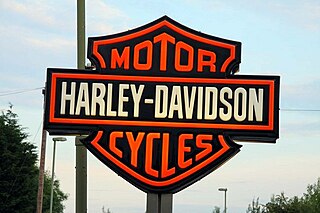
Harley-Davidson, Inc. is an American motorcycle manufacturer headquartered in Milwaukee, Wisconsin, United States. Founded in 1903, it is one of two major American motorcycle manufacturers to survive the Great Depression along with its historical rival, Indian Motorcycles. The company has survived numerous ownership arrangements, subsidiary arrangements, periods of poor economic health and product quality, and intense global competition to become one of the world's largest motorcycle manufacturers and an iconic brand widely known for its loyal following. There are owner clubs and events worldwide, as well as a company-sponsored, brand-focused museum.

A flat-twin engine is a two-cylinder internal combustion engine with the cylinders on opposite sides of the crankshaft. The most common type of flat-twin engine is the boxer-twin engine, where both pistons move inwards and outwards at the same time.
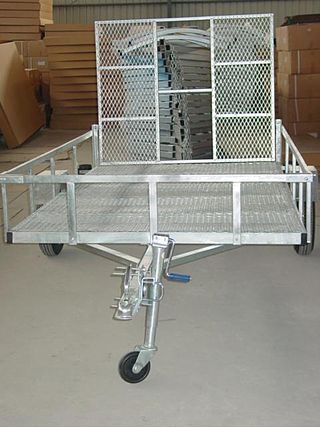
A trailer is an unpowered vehicle towed by a powered vehicle. It is commonly used for the transport of goods and materials.

A swingarm, or "swinging arm" (UK), originally known as a swing fork or pivoted fork, is a single or double sided mechanical device which attaches the rear wheel of a motorcycle to its body, allowing it to pivot vertically. The main component of the rear suspension of most modern motorbikes and ATVs, it holds the rear axle firmly, while pivoting to absorb bumps and suspension loads induced by the rider, acceleration, and braking.

A three-wheeler is a vehicle with three wheels. Some are motorized tricycles, which may be legally classed as motorcycles, while others are tricycles without a motor, some of which are human-powered vehicles and animal-powered vehicles.

The Harley-Davidson Sportster is a line of motorcycles produced continuously since 1957 by Harley-Davidson. Sportster models are designated in Harley-Davidson's product code by beginning with "XL". In 1952, the predecessors to the Sportster, the Model K Sport and Sport Solo motorcycles, were introduced. These models K, KK, KH, and KHK of 1952 to 1956 had a sidevalve engine, whereas the later XL Sportster models use an overhead valve engine. The first Sportster in 1957 had many of the same features of the KH including the frame, fenders, large gas tank and front suspension.

The Harley-Davidson WLA is a Harley-Davidson motorcycle that was produced to US Army specifications in the years during and around World War II. It was based on an existing civilian model, the WL, and is of the 45 solo type, so called due to its 45-cubic-inch (740 cm3) engine displacement and single-rider design. It acquired the nickname "Liberator".
Harley-Davidson engines are a line of engines manufactured since 1903 in Milwaukee, Wisconsin by the Harley-Davidson company for use in its motorcycles. Harley-Davidson engines are now made at Harley-Davidson Motor Company's Pilgrim Road Powertrain Operations facility in Menomonee Falls, Wisconsin.
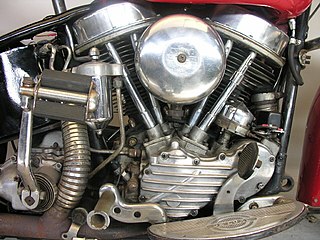
Harley-Davidson FL is a model designation used for Harley-Davidson motorcycles since 1941, when F referred to the new large capacity 74 cui (1200cc) variant of the V-2 Overhead valve engine (″Knucklehead″) that was introduced in 1936 as Model E with 61 cui (1000cc). The presence of an additional letter L indicated higher compression, offering more power but requiring higher octane gasoline. In 1950s, the low compression version was discontinued, and in 1952 also the low capacity EL, making FL the standard engine and model designation for decades to come.
The Harley-Davidson Super Glide was a motorcycle made by the Harley-Davidson. Reputed to be the first factory custom motorcycle, it originated Harley-Davidson's FX series of motorcycles by mating Sportster components, most notably the front end, with the chassis of their larger big twin motorcycles. Super Glide models from 1991 to 2018 were based on the Dyna Glide chassis which has a wider variety of front ends and trim levels, and for a time filled the intermediate niche between the smallest and largest Harley-Davidson models; the Dyna platform has since been discontinued for the 2018 model year in favor of the new Softail frame, with some models from the Dyna nameplate being carried over to the Softail line.
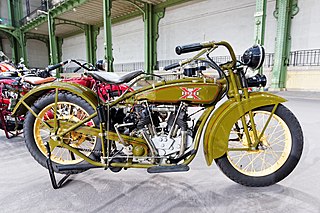
The Excelsior Super X was a motorcycle manufactured by the Excelsior Motor Manufacturing & Supply Company from 1925 to 1931. It was the most famous Excelsior motorcycle manufactured by that company and was the first American forty-five cubic inch motorcycle.

The Indian 841 was a motorcycle designed by the Indian Motocycle Manufacturing Co. for desert warfare. It pioneered the drivetrain configuration later popularized by Moto Guzzi, having a longitudinally mounted air-cooled 90-degree V-twin with shaft drive to the rear wheel.
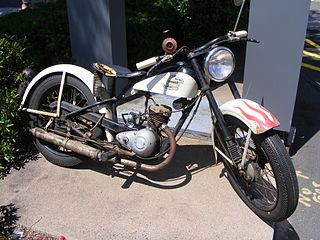
The Hummer was a motorcycle model manufactured by Harley-Davidson from 1955 to 1959. However, the name "Hummer" is now incorrectly used generically to refer to all American-made single-cylinder two-stroke Harley-Davidson motorcycles manufactured from 1948 to 1966. These motorcycles were based on the DKW RT125, the drawings for which were taken from Germany as war reparations after World War II. The RT125 drawings were also given to the United Kingdom and the Soviet Union as war reparations, resulting in the BSA Bantam and the MMZ M-1A Moskva, later known as the Minsk.
William Godfrey "Willie G." Davidson is an American businessman and motorcycle designer, and the former senior vice president & chief styling officer of Harley-Davidson Motor Company. He was also the head of Harley-Davidson's Willie G. Davidson Product Development Center in Wauwatosa, Wisconsin. While being generally responsible for approving Harley-Davidson motorcycle designs, he also personally designed several motorcycles for Harley-Davidson, including the Super Glide and the Low Rider, which pioneered the factory custom motorcycle and created an intermediate line of motorcycles between their large touring models and their smaller Sportsters.

Simplex Manufacturing Corporation was an American manufacturer that made motorcycles from 1935 to 1975. Between 1935 and 1960, Simplex made variations of the Simplex Servi-Cycle including the 1953–1960 Simplex Automatic. Simplex was the only motorcycle manufacturer located in the Deep South for many years, until Confederate Motorcycles began production.

The Harley-Davidson RL 45 is a model of the R-series range produced from 1932 to 1936, preceded by the DL range (1929-1931), which was Harley-Davidson's first 45 cubic-inch and first flathead V-twin motorcycle, and succeeded in 1937 by the WL. The R-series range included 45-solo, R, RL and RLD models. The RL, like the DL before it, featured a total-loss oiling system; the following WL had a recirculating oil system.

The Harley-Davidson Tri Glide Ultra Classic is a three-wheeled motorcycle manufactured by Harley-Davidson and introduced in the 2009 model year. Its model designation is FLHTCUTG.

The Harley-Davidson Model W, also known as the Sport Twin, is a motorcycle made by Harley-Davidson from 1919 to 1923. Unusually for a Harley-Davidson motorcycle, the Model W had a flat-twin engine and a trailing link fork. The Model W set speed records on runs from New York City to Chicago and from the Canada–United States border to the Mexico–United States border. Slow home market sales led to the end of production after four years.

Flathead motorcycles are a type of bike that was a standard for pre-war motorcycles, in particular US V-twins such as Harley-Davidson and Indian, some British singles, BMW flat twins and Russian copies thereof.
The company also introduced the first of their three-wheeled Servi-Cars in 1932, powered by the 45-cid V-twin.
Some suggested that it was inspired by Far East rickshaw-style machines; however, the Servi-Car was initially intended for the recovery of broken-down cars — hence the tow-bar and huge 60 amp/hour battery fitted as standard.
A model-specific brochure was produced for the Servi-Car for 1934, in which it was described as 'the practical method for profitable pick-up and delivery of automobiles.'
1964: KRTT DROPPED, FIRST ELECTRIC START HARLEY: THE SERVICAR